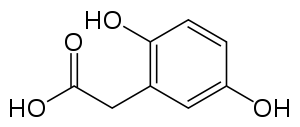Homogentisic acid
 | |
 | |
| Names | |
|---|---|
| IUPAC name
(2,5-Dihydroxyphenyl)acetic acid | |
| Other names
Melanic acid | |
| Identifiers | |
3D model (JSmol) |
|
| ChEBI | |
| ChemSpider | |
| DrugBank | |
| ECHA InfoCard | 100.006.540 |
| KEGG | |
| MeSH | Homogentisic+acid |
PubChem CID |
|
| |
| |
| Properties | |
| C8H8O4 | |
| Molar mass | 168.15 g·mol−1 |
| Melting point | 150 to 152 °C (302 to 306 °F; 423 to 425 K) |
Except where otherwise noted, data are given for materials in their standard state (at 25 °C [77 °F], 100 kPa). | |
| Infobox references | |
Homogentisic acid (2,5-dihydroxyphenylacetic acid) is a phenolic acid usually found in Arbutus unedo (strawberry-tree) honey.[1] It is also present in the bacterial plant pathogen Xanthomonas campestris pv. phaseoli[2] as well as in the yeast Yarrowia lipolytica[3] where it is associated with the production of brown pigments. It is oxidatively dimerised to form hipposudoric acid, one of the main constituents of the 'blood sweat' of hippopotamuses.
It is less commonly known as melanic acid, the name chosen by William Prout.
Human pathology
Accumulation of excess homogentisic acid and its oxide, named alkapton, is a result of the failure of the enzyme homogentisic acid 1,2-dioxygenase (typically due to a mutation) in the degradative pathway of tyrosine, consequently associated with alkaptonuria.[4]
Intermediate
It is an intermediate in the catabolism of aromatic amino acids such as phenylalanine and tyrosine.
References
- ↑ Paolo Cabras; Alberto Angioni; Carlo Tuberoso; Ignazio Floris; Fabiano Reniero; Claude Guillou; Stefano Ghelli (1999). "Homogentisic Acid: A Phenolic Acid as a Marker of Strawberry-Tree (Arbutus unedo) Honey". J. Agric. Food Chem. 47 (10): 4064–4067. doi:10.1021/jf990141o.
- ↑ Goodwin PH, Sopher CR (1994). "Brown pigmentation of Xanthomonas campestris pv. phaseoli associated with homogentisic acid". Canadian Journal of Microbiology. 40 (1): 28–34. doi:10.1139/m94-005.
- ↑ Alexandra Carreira; Luísa M. Ferreira; Virgílio Loureiro (2001). "Brown Pigments Produced by Yarrowia lipolytica Result from Extracellular Accumulation of Homogentisic Acid". Appl Environ Microbiol. 67 (8): 3463–3468. CiteSeerX 10.1.1.319.523. doi:10.1128/AEM.67.8.3463-3468.2001.
- ↑ Phornphutkul C, Introne WJ, Perry MB, et al. (2002). "Natural history of alkaptonuria". New England Journal of Medicine. 347 (26): 2111–21. doi:10.1056/NEJMoa021736. PMID 12501223.